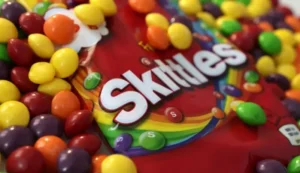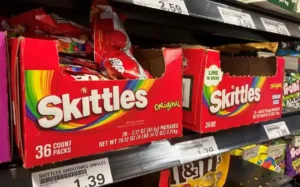Understanding California’s Food Safety Act and the “Skittles Ban”. In a groundbreaking move, Governor Gavin Newsom recently inked the California Food Safety Act into law.
With this historic legislation, California has taken the lead in the nation by becoming the first state to ban specific food additives.
This monumental act effectively puts the brakes on the use of certain additives, notably brominated vegetable oil, potassium bromate, propylparaben, and red dye No. 3.
Affectionately dubbed the “Skittles ban” due to its association with the colorful candies, the California Food Safety Act, officially known as Assembly Bill 418, is set to change the food landscape.
It imposes a clear and unambiguous restriction on individuals and businesses, forbidding them from engaging in any activity related to the production, sale, delivery, distribution, possession, or offering for sale of any food containing the aforementioned additives.
But What Do These Additives Mean for You?
To truly grasp the significance of this legislation, it’s essential to delve into the nature of the additives themselves. Let’s explore each of them and their presence in various processed foods, including some breakfast cereals and candies.
1. Brominated Vegetable Oil (BVO):
– BVO has long been used as an emulsifier in citrus-flavored beverages. Its presence in such products may lead to questions about its health implications.
2. Potassium Bromate:
– Commonly used in bread and bakery items, potassium bromate has raised concerns about potential carcinogenic effects.
3. Propylparaben:
– Often used as a preservative, propylparaben has come under scrutiny for its possible hormonal effects.
4. Red Dye No. 3:
– Found in numerous colored foods, including candies, this dye has been associated with various health concerns.
Understanding the Implications:
The California Food Safety Act is a bold step toward ensuring the safety and well-being of consumers. It reflects a growing awareness of the need to scrutinize the ingredients in our food and make informed choices. While Skittles may have inadvertently become the poster child for this legislation, the ban extends far beyond colorful confections.
The “Skittles ban” serves as a reminder of the importance of transparency in the food industry. By limiting the use of certain additives, California is taking a proactive stance in safeguarding public health.
As this legislation paves the way for future changes in the food landscape, consumers are encouraged to stay informed about what goes into their favorite treats and to make choices that align with their health and wellness goals.
The Real Scoop on California’s “Skittles Ban”
As the clock ticks toward the implementation of California’s Food Safety Act, there’s been quite a stir around the supposed “Skittles ban.” With hefty fines and an imminent law change, many are curious to know: Are Skittles really on the chopping block in the Golden State? Let’s uncover the facts.
First and foremost, let’s address the financial penalties. According to the bill, individuals or businesses found in violation of the law will face consequences.

The Real Scoop on California’s “Skittles Ban”
A first offense may result in fines of up to $5,000, while subsequent violations could soar to a daunting $10,000. These fines are nothing to scoff at, emphasizing the seriousness of the legislation. The California Food Safety Act is scheduled to take effect on January 1, 2027, so the countdown is on.
The short answer is no. Despite the buzz and rumors swirling around Skittles being “banned” in California, there’s more to the story.
In fact, Governor Newsom addressed this head-on in a letter to the state assembly right after he signed the bill into law. He explicitly stated, “there have been many misconceptions about this bill and its impacts.”
It’s not Skittles themselves that are facing the chopping block, but rather four specific additives that find their way into Skittles and other cereals and candies. These additives include brominated vegetable oil, potassium bromate, propylparaben, and red dye No. 3. Companies manufacturing these treats will need to adjust their recipes to align with the new law.
Jamie Alan, PhD, an associate professor of pharmacology and toxicology at Michigan State University, sheds light on the situation. She emphasizes that companies have the capability to produce products without these additives. So, despite the initial speculation, it’s clear that “no, [Skittles] will not be banned.”
The “Skittles ban” may have grabbed headlines, but it’s crucial to discern the actual scope of this legislation. It’s not just about Skittles; it’s about food safety and public health.
The impending changes serve as a reminder that the food industry is evolving, and consumers are becoming increasingly discerning about what they consume. As we approach the January 1, 2027, implementation date, the industry and its patrons have much to contemplate.
California Food Safety Act: Separating Fact from Fiction on Skittles and More
The recent enactment of the California Food Safety Act has sparked a flurry of discussions, particularly around the beloved treat, Skittles.
Governor Newsom’s letter addressing this groundbreaking legislation raised eyebrows when it specifically mentioned Skittles and even included a photo of a Skittles bag from the European Union, which has already banned various chemical additives and colors.
This gesture aimed to underline an essential point: the food industry can adapt to varying public health laws, country by country.
One key aspect to note is that this bill won’t take full effect until 2027. This ample window of time allows brands to reevaluate and reformulate their recipes, steering clear of the harmful chemicals outlined in the legislation. The upshot? Californians can continue to savor their favorite food products with the added assurance of safety.
Assemblymember Jesse Gabriel, the architect behind this law, expressed his jubilation at its passage. Notably, he emphasized a fact that’s music to Skittles enthusiasts’ ears: “Skittles will not be banned. I would vote against anything that would ban Skittles. I love Wild Berry Skittles.”
Melanie Benesh, Vice President of Government Affairs for the Environmental Working Group, weighed in on the matter. She offered a reassuring perspective, stating, “there’s no realistic chance that this bill will result in any products, including Skittles, being pulled from shelves.
Companies will simply change their recipes to match what they’re already selling in other places where red dye No. 3, propyl paraben, potassium bromate, and BVO are banned.”
The “Skittles ban” saga showcases the evolving landscape of food safety regulations and the determination to safeguard public health. While the California Food Safety Act brings about changes, it’s not the end of beloved treats like Skittles.
The grace period until 2027 offers an opportunity for brands to adapt and ensures Californians can continue to indulge in their favorite snacks with renewed confidence in their safety.

Unpacking the Ban on Harmful Additives: Why Now?
The recent enactment of the California Food Safety Act has left many wondering: why the sudden focus on additives? To understand this seismic shift in food safety regulations, we need to delve into the reasons behind the ban. Melanie Benesh, Vice President of Government Affairs for the Environmental Working Group, sheds light on the matter.
According to Benesh, the additives targeted by the new law have long raised eyebrows in terms of safety. The concerns surrounding these additives are not new. For instance, she points out that the Food and Drug Administration (FDA) took steps to ban various uses of red dye No. 3 back in 1990, including its application in cosmetics.
This decision came on the heels of studies indicating potential carcinogenic effects associated with high doses of this dye. Surprisingly, the FDA didn’t extend this ban to food, leaving a lingering question about its safety.
Adding another layer of concern, some studies have suggested a link between red dye No. 3 and issues like hyperactivity and decreased attention spans in children. Melanie Benesh emphasizes that certain children may be more susceptible to these negative health effects, making the presence of such additives in processed foods, including candy and cookies, an area of particular concern.
Assemblymember Jesse Gabriel points out an intriguing global perspective. These ingredients, which are under scrutiny in California, have already been banned in various other countries. He notes, “Dozens of chemicals that are banned in other parts of the world are somehow still allowed in food in the US.” This incongruity raises questions about the consistency of regulations and their alignment with public health.
One striking revelation in this debate is the contrasting treatment of red dye No. 3 in cosmetics versus food. Gabriel highlights this paradox, noting that the government deems this substance too toxic for facial application but permits its inclusion in our diets. This incongruity has left many scratching their heads, wondering about the logic behind such decisions.
The ban on these additives is driven by concerns about their safety, particularly when it comes to children’s health. As the California Food Safety Act ushers in a new era of food safety regulations, it prompts a critical reevaluation of ingredients that have long been part of our food landscape.
This legislation not only reflects the need for transparency but also the importance of aligning food regulations with global standards and safeguarding the well-being of consumers, both young and old.
The Future of Skittles: What to Expect in 2027
As the California Food Safety Act is set to usher in a new era of food regulations, it’s only natural to wonder about the fate of iconic treats like Skittles. With a three-year grace period built into the legislation, what can Skittles lovers expect as 2027 approaches? Let’s unravel the future of Skittles in light of these changes.
Manufacturers now have a generous three-year window to adjust their recipes and implement “minor modifications” in order to align with the new law. While this may seem like a tall order, experts believe that consumers might not even notice the shift.
According to Daniel Ganjian, MD, a pediatrician at Providence Saint John’s Health Center in Santa Monica, Calif., the transition is likely to be swift, seamless, and, most importantly, imperceptible in terms of taste or appearance.
Assembly-member Jesse Gabriel, the driving force behind the California Food Safety Act, envisions broader implications beyond the Golden State. He anticipates that other states might follow suit, considering similar legislation.
Additionally, he foresees companies opting for a nationwide recipe switch rather than creating separate formulas for different regions. As he succinctly puts it, “It’s highly unlikely that someone is going to make one candy for California and another candy for Oklahoma.” In essence, the impact of this legislation is poised to extend far beyond California’s borders.
The year 2027 holds promise for a new chapter in the story of Skittles. With manufacturers diligently reworking their recipes to align with California’s food safety laws, Skittles aficionados can rest assured that their beloved candies will continue to delight their taste buds.
As the Golden State paves the way, it’s possible that this pioneering legislation will serve as a catalyst for change, not just in California but across the entire nation. It’s a tantalizing taste of what the future holds for the world of food safety and regulations.


